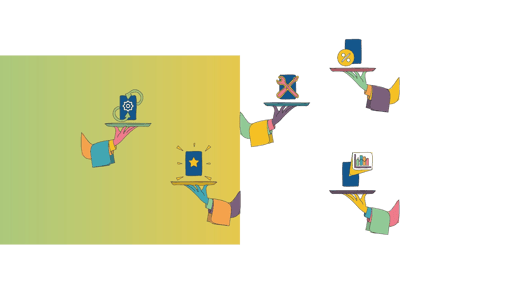
Asset driven innovation - unlocking capex barriers to new product innovation
November 2020
By Adrian Swinburne - Head of Consumer Sector at 42 Technology
An experienced consultant's view on how to prevent new product ideas from failing

Within the consumer packaged goods industries – sectors that are a major focus of 42 Technology’s work – we often see our clients investing in the creation of innovative new product ideas, only for those ideas to fail due to the limitations of existing manufacturing capabilities or capex restrictions.
These ideas might hold the promise of securing significant new revenues, either through delivering new consumer experiences or by addressing new use cases or consumption opportunities, but short-term capex constraints can take precedent over longer term opportunities.
At worst, ideas may be axed when handed over to the production engineering teams with a dismissal on the basis of “we can never manufacture that!”
If this barrier could be eliminated early in the NPI process, how many of these innovative new product ideas might make a more smooth and successful transition into the factory?
Exploiting the latent capabilities of your assets
In our work, we are often presented with challenges such as …
we’d love to create a new product that exploits this opportunity we have identified, but need to ensure that any new product is manufacturable using our existing assets
And it is in this type of project where 42 Technology team’s mix of creative product design, coupled with practical process engineering, has proved to be successful.
Rather than innovating in isolation of the practicalities of manufacturing, what if the capabilities of your existing manufacturing assets are used as the seeds for that product innovation?
By thinking more broadly about what your assets can, and importantly, can’t do, it may be possible to identify new compelling product attributes that can easily be realised with no or minimal new capital investment.
This is what we mean when we talk about 'asset driven' innovation.
But isn’t that rather like technology push?
New products should be motivated by addressing genuine market and consumer needs rather than trying to, perhaps artificially, construct a new product proposition around an interesting piece of technology. Market pull is always likely to triumph over technology push.
So isn’t asset driven innovation simply technology push in the context of manufacturing capabilities?
To some extent, yes, but with some important differences.
Technology push might be seen as trying to answer the question “what new products might this exciting new technology enable?” and that might lead to identification of compelling new ideas. But rarely does this process lead to a well-developed proposition that can (or should) immediately be taken forward.
At minimum, robust market assessment is needed to validate that there is genuine value in the new proposition, and that it will deliver tangible benefits compared to the current solutions. Often findings are less positive than expected.
Asset driven innovation is in many ways akin to this technology driven approach, but endeavours to answer the questions …
"what other unsatisfied market needs might the capabilities of our manufacturing assets be able to deliver, and how far might we be able to extend the envelope of those capabilities beyond what we currently understand?"
By deconstructing manufacturing assets into their component parts, each of which will currently be performing a distinct and well understood function within the overall manufacturing process, the capabilities of each of those parts can be explored in depth to understand the full range of capability that might exist at that stage of the process. The complete spectrum of capabilities can then form the framework to explore how those latent capabilities might be exploited in the realisation of new products.
As for technology push, the market assessment must still be carried out, but at least it is on the basis of a product for which manufacturing practicality has already been validated.
So where to start?
Identifying the particular assets to be explored will typically be driven by understanding which are significantly under-utilised, or which may have under-exploited flexibility that could be used for other products.
Having identified the target assets, the end-to-end process should be properly deconstructed into its component parts, and each of these steps explored to understand how far it can be extended beyond its current purpose. This could include, for example, exploring what range of materials it might be able to handle, what range of thermodynamic properties might be achievable, or what range of shapes and formats might be producible.
It is important during this process to involve the right people – the engineers and operators who have in-depth experience of the line, but might have preconceived views on how it is able to operate, as well as the naïve experts who will understand the principles of the manufacturing line but may not be subject to the same constraints of imagination.
What will likely emerge will be a range of capabilities for each process step that can be used as the palette for creating composite manufacturing solutions, as well as allowing the team to consider what types of products might be envisaged by previously unseen manufacturing capabilities, or through minor modification or reordering of the existing process steps.
Not a completely smooth and trouble-free process
The process described above requires careful thought, both in its planning and execution, and use of experienced facilitators and structured innovation tools will bring tremendous benefit both in terms of the ability to challenge the preconceived views on the process capabilities, as well as the breadth of new product ideas, or idea fragments, that might be generated.
And it is also likely that not all of the resulting ideas will be viable, either due to an unrealistic view of market attractiveness, or due to unforeseen constraints on changing a manufacturing line such as the cost of recertification of a line following any change.
But the palette of ideas is likely to be unexpectedly large and provide a rich source of inspiration for the product innovation process.
Developing a plan for success
Before diving into the detail, it is recommended that clarity is established over the following:
- Which assets should be the focus for the exercise, and how far upstream and downstream is in scope? Set the scope wide enough to provide the space to be creative without being over-ambitious.
- Who will be involved in the process to ensure the right balance of process knowledge and experience, naïve experts, experience from other industries, and structured innovation practitioners?
- What criteria should be used to judge a successful outcome? Defining success criteria in advance will ensure objectivity and lack of bias when judging subsequent ideas.
The detailed process mapping can then be carried out. And by applying an appropriate level of abstraction to determine the generic functional transformation being made at each process step.
Each step should then be explored and challenged to ascertain the full breadth of potential capability. Significant latent capabilities identified during this process can be used as individual seeds for technology push type innovation activities.
Creation of the complete capability palette will then allow previously unexplored process configurations to be identified as enablers to novel product formats.
Assessment of new product ideas against the success criteria identified at the start of the process, as well as robust assessment of the customer/consumer need and market opportunity, must be carried out for the short-listed ideas.
It may be seen as an unconventional approach to new product innovation, but the result will be greater confidence that new ideas can be realised without falling foul of the practicalities of manufacturing or capex restrictions.
If you would like to find out more please contact us:
answers@42T.com | +44 (0)1480 302700

Adrian leads 42 Technology’s work on the consumer sector, developing and managing 42 Technology’s clients in the food, beverage, home care and personal care sectors.
Share this article:
Related Articles

Innovation, Product Design
Embracing innovation: the future of product development

Innovation, 2024 Technology Trends
AI powered innovation - the disrupting force transforming the market

Innovation, 2024 Technology Trends
Service-dominant logic - innovation process next steps

What will you ask us today?
We believe in asking the right questions to drive innovation; when we know the right questions, we generate the ideas to answer them.

